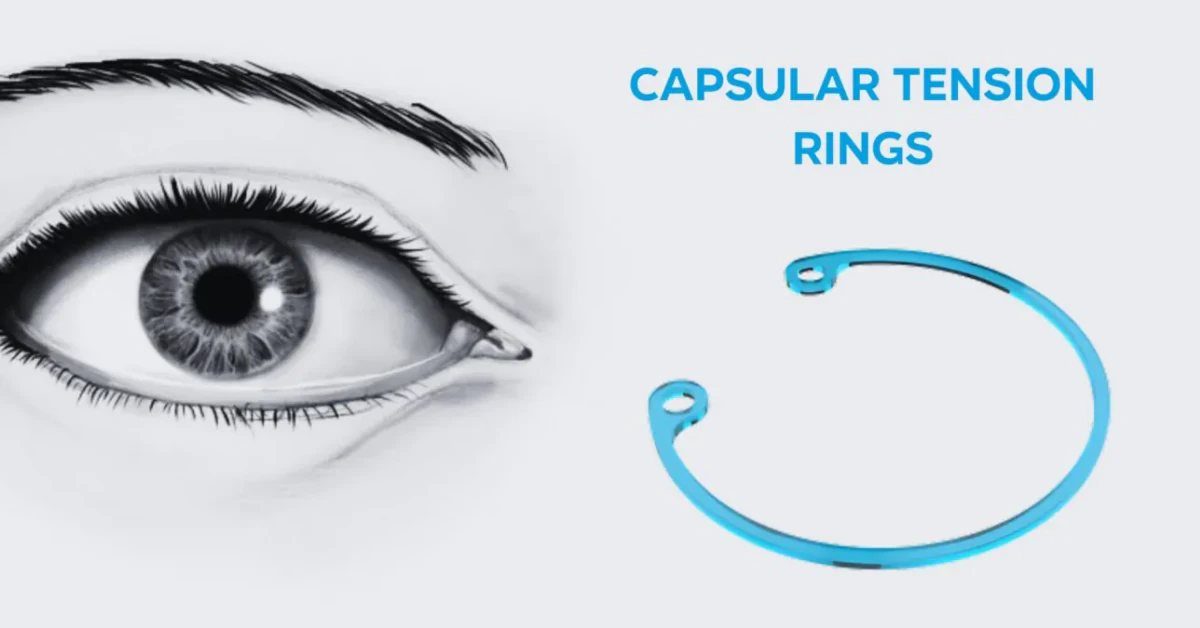“At first, I thought it was nothing…”
Yup, that’s how it started. I mean, until I saw a patient’s intraocular lens shift mid-surgery—like watching a piece of Legos fall out of place—and realized I needed a better plan. Ever felt that cold panic in the OR when things just… don’t go according to textbook?
Turns out, I wasn’t alone. Surgeons everywhere started whispering about this little C-shaped device called the capsular tension ring (CTR). Some said it was a lifesaver; others warned it could turn surgery into a full-blown horror show if you messed up the timing. So what’s the real deal?
This story isn’t just about gadgets. It’s about how one tiny ring could save your patient’s vision or—ouch!—turn into a disaster. Let’s unpack the science, the struggles, and why timing matters more than you’d think.
CTR 101: What Exactly Is This Thing?
Imagine your eye as a tricky little balloon with walls thinner than a Snickers wrapper (okay, maybe thinner). When those walls—called zonules—get weak, it’s like holding a deflated soccer ball and trying to keep the valve centered. That’s where the CTR comes in: it props up the capsular bag, redistributing tension to keep your intraocular lens (IOL) where it belongs.
The “Aha!” Moment
Back in 1991, some genius named Hara decided, “You know what we need? A way to keep the eye’s bag round after cataract surgery.” Enter the “equator ring,” later rebranded as the CTR. Fast forward to 1993, and Witschel and Legler slapped it into their first human eye during surgery. The verdict? It worked… most of the time.
Why It Matters
Zonular weakness isn’t just a niche problem. It’s the sneaky villain in cases like pseudoexfoliation, trauma, or even age-related wobble. Without a CTR? The IOL might drift off-center, leaving your patient with blurry vision worse than morning-after guilt.
| Year | Innovation |
|---|---|
| 1991 | First “equator ring” concept for capsular shape |
| 1993 | First human CTR implantation |
| 1998 | Cionni ring: Modified for eyelet-based scleral fixation |
| 2002 | Partial Ahmed CTS segments for tricky cases |
CTR’s Magic—and Why It’s Not Always Fairy-Tale Perfect
Okay, let’s get real. CTRs are like that friend who shows up with snacks at your birthday party—super reliable when they’re on point, but man, if they flake…
Let me explain.
The Good Stuff
CTR implantation helped stabilize the capsular bag, reducing intraoperative drama. Surgeons swear their IOLs stay put way better, even in tough cases like progressive zonulopathy. One study even put stars in their eyes, showing improved postoperative outcomes for high-risk patients. Love that teamwork energy, right?
But, Get This…
Here’s where things get messy:
- Early CTR placement turns cortex removal into a wrestling match. “Yikes!” one surgeon muttered, trying not to ping that slippery ring across the OR.
- Late implantation? The posterior capsule starts doing this weird rippling dance, risking rupture if you sneeze too hard.
- Oh, and if the patient’s capsule is already torn? That CTR might act like a blender on high-speed, ripping things up further—you don’t want that.
Timing Is… Everything
Picture this: You’re halfway through phacoemulsification, and your gut says, “Hey, maybe we should’ve dropped that CTR in earlier.” Too late. The capsule’s wobbling like jelly on a slide, and now you’ve got posterior fluctuations from the JAMA review whispering warnings on loop.
Early vs. Late: The Hot Debate
Early placement? Smooths out the bag like a hammock in a hurricane—but can make cortex cleanup feel like scraping gum off your shoe.
Late? You’re relying on luck. By then, the bag’s already writhing, and you’re dancing with a partner who might trip you both. Surgeons often split hairs here: older bags, smaller pupils, zonular holes the size of sink drains? Research says “risk for intraoperative complications is higher than in healthy eyes.”
Real Talk: A Surgeon’s Dilemma
We’ve all made that face—half surprise, half dread—when the capsular bag’s like… bigger than Bigfoot’s shoe size.
“Wait, the size correlates with axial length?!” Yep, turns out eyes longer than usual (or staring too hard at screens, maybe?) need bulkier CTRs. But if you miss the mark, that ring could turn your surgery into a Pinocchio nose: too much stress, too little support.
Modified Rings: Because Not Every Eye Fits Standard
Let’s face it: Eyes are like snowflakes—no two are the same. That’s why regular CTRs just weren’t enough for cases with more than three clock hours of zonular loss. Thank heavens for modified rings.
Meet the Cionni Ring
Robert Cionni rolled up in 1998 with an open-ring design. The heroics? Eyelets for scleral suturing. The genius? Let’s just say it’s the rebel who fixes what standard CTRs can’t handle. GOT IT?
Then There’s Ahmed CTS
Ike Ahmed’s 2002 tweak threw us a bone: partial segments that don’t need a dialing technique. Saves time, cuts effort, but don’t expect miracles on a lazy Sunday—still needs skill in real-time. Memo to all? “Capsular support devices should be considered in complex cases.” Word.
The Limits: When CTR Won’t Save You
This isn’t a “slap-a-CTR-and-hope” situation. If the zonules are hemorrhaging like confetti, even modified rings won’t stick around. Talk to a specialist. Now.
| Type | When to Use | Key Perk |
|---|---|---|
| Standard CTR | Mild to moderate zonulopathy | Easy insertion; budget-friendly |
| Cionni Ring | Zonules missing over 4 clock hours | Permanent scleral fixation |
| Ahmed CTS | Targeted zonular gaps | No dialing required |
Contraindications: Don’t Do This at Home
Shocking, I know, but CTRs aren’t for everyone. Here’s the rub:
- Kids under 12? Eyes still growing—CTR goes strictly out the window, per the FDA’s instruction manual.
- Already cracked capsule? CTR becomes the equivalent of “fixing” a cracked iPhone with a wrench. Just don’t.
Bottom line: Timing and pre-op clarity are your BFFs.
Long-Term Risks: The Movie Plot Twist
Here’s the thing—CTR might fix today’s problem but haunt tomorrow. Patients with capsular contraction syndrome could still face bag shrinkage and lens drift down the line. One case hit hard: Mr. Smith, regular as your morning coffee, comes back two years later with lens subluxation. His CTR? Still in place, like a loyal soldier who just couldn’t keep up with the rebellion.
Lesson learned: Long-term follow-up isn’t extra—it’s essential. Especially if their zonulopathy keeps evolving. Because yeah, even a CTR can’t predict the future.
MRI Safety: Yep, You’re Good
Ever had a patient freak out about “magnets” from the CTR in an MRI? Breathable sighs all around. Most rings (your Ophtec, your Ahmed CTS) use non-magnetic, biocompatible materials. So unless the black box label says otherwise, they’re fit for brain scans Feb 3, 2025 report to back it up.
When Is CTR Worth It? Risk vs. Reward
CTR implantation: Not a Hail Mary. And not completely flawless. But when you’ve got a patient with skull-divided zonules—pseudoexfoliation, trauma, you name it—it’s the superhero cape that limits damage without going full Spider-Man.
- Life sure gets better post-CTR for some: Fewer dislocations, clearer vision, no more side-eye from vision charts.
- But? You’ve gotta respect the risks. Implant it too early, you’re fighting cortex removal. Too late, you’ve got a bag bouncing around in slow motion.
Evidence to Walk Back
Lab results say “CTR improves intraocular lens centration.” But the same team noted—surprise!—it’s not magic. A few 86-case studies showed zero dislocations in properly placed CTRs. Still, nothing’s perfect. Keep your eyes peeled for late complications.
Seeing the Bigger Picture
Let’s zoom out. Capsular tension rings are an evolution, not the endgame. Surgeons used to deal with dislocations and partial zonular support, staring down the barrel of a cataract without a safety net. Now? We’ve got rings, segments, and debates that keep our field alive.
But this isn’t a tech review—it’s a heads-up. Life after surgery isn’t one-size-fits-all. CTR? It’s your ally, your compromise, not a fairy tale. You need the right balance… and maybe a few CpG citations right along the way.
So What’s Next?
If you’re a patient, this might feel like learning the 5th rule to baking a soufflé—a lot of steps, and just one wrong move makes it fall. But hey, if you know your surgeon chose the right CTR implantation time, you’ve got a better shot at nailing it than the YouTube chef with two stars.
For surgeons: Don’t overestimate the “you got this” vibe. Keep your radar for zonulopathy sharper than your phaco tip. And if you ask me, CTR is our jam when used right… not a lazy weekend Band-Aid.
Got questions? Curious how this applies to your practice (or your own operation)? Drop a line on forums, start a discussion board saga, or just shoot me a comment here. Let’s keep unmasking the hype—and backing it with science.


















Leave a Reply
You must be logged in to post a comment.